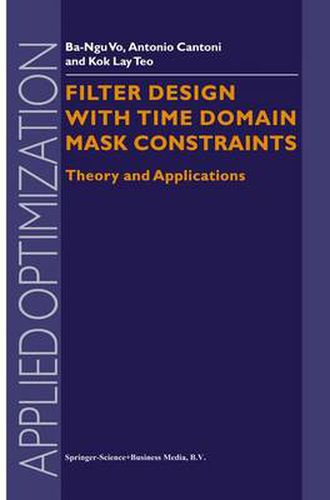Readings Newsletter
Become a Readings Member to make your shopping experience even easier.
Sign in or sign up for free!
You’re not far away from qualifying for FREE standard shipping within Australia
You’ve qualified for FREE standard shipping within Australia
The cart is loading…






This title is printed to order. This book may have been self-published. If so, we cannot guarantee the quality of the content. In the main most books will have gone through the editing process however some may not. We therefore suggest that you be aware of this before ordering this book. If in doubt check either the author or publisher’s details as we are unable to accept any returns unless they are faulty. Please contact us if you have any questions.
Optimum envelope-constrained filter design is concerned with time-domain synthesis of a filter such that its response to a specific input signal stays within prescribed upper and lower bounds, while minimizing the impact of input noise on the filter output or the impact of the shaped signal on other systems depending on the application. In many practical applications, such as in TV channel equalization, digital transmission, and pulse compression applied to radar, sonar and detection, the soft least square approach, which attempts to match the output waveform with a specific desired pulse, is not the most suitable one. Instead, it becomes necessary to ensure that the response stays within the hard envelope constraints defined by a set of continuous inequality constraints. The main advantage of using the hard envelope-constrained filter formulation is that it admits a whole set of allowable outputs. From this set one can then choose the one which results in the minimization of a cost function appropriate to the application at hand. The signal shaping problems so formulated are semi-infinite optimization problems. This monograph presents in a unified manner results that have been generated over the past several years and are scattered in the research literature. The material covered in the monograph includes problem formulation, numerical optimization algorithms, filter robustness issues and practical examples of the application of envelope constrained filter design. Postgraduate students, researchers in optimization and telecommunications engineering, and applied mathematicians should find this work useful.
$9.00 standard shipping within Australia
FREE standard shipping within Australia for orders over $100.00
Express & International shipping calculated at checkout
This title is printed to order. This book may have been self-published. If so, we cannot guarantee the quality of the content. In the main most books will have gone through the editing process however some may not. We therefore suggest that you be aware of this before ordering this book. If in doubt check either the author or publisher’s details as we are unable to accept any returns unless they are faulty. Please contact us if you have any questions.
Optimum envelope-constrained filter design is concerned with time-domain synthesis of a filter such that its response to a specific input signal stays within prescribed upper and lower bounds, while minimizing the impact of input noise on the filter output or the impact of the shaped signal on other systems depending on the application. In many practical applications, such as in TV channel equalization, digital transmission, and pulse compression applied to radar, sonar and detection, the soft least square approach, which attempts to match the output waveform with a specific desired pulse, is not the most suitable one. Instead, it becomes necessary to ensure that the response stays within the hard envelope constraints defined by a set of continuous inequality constraints. The main advantage of using the hard envelope-constrained filter formulation is that it admits a whole set of allowable outputs. From this set one can then choose the one which results in the minimization of a cost function appropriate to the application at hand. The signal shaping problems so formulated are semi-infinite optimization problems. This monograph presents in a unified manner results that have been generated over the past several years and are scattered in the research literature. The material covered in the monograph includes problem formulation, numerical optimization algorithms, filter robustness issues and practical examples of the application of envelope constrained filter design. Postgraduate students, researchers in optimization and telecommunications engineering, and applied mathematicians should find this work useful.